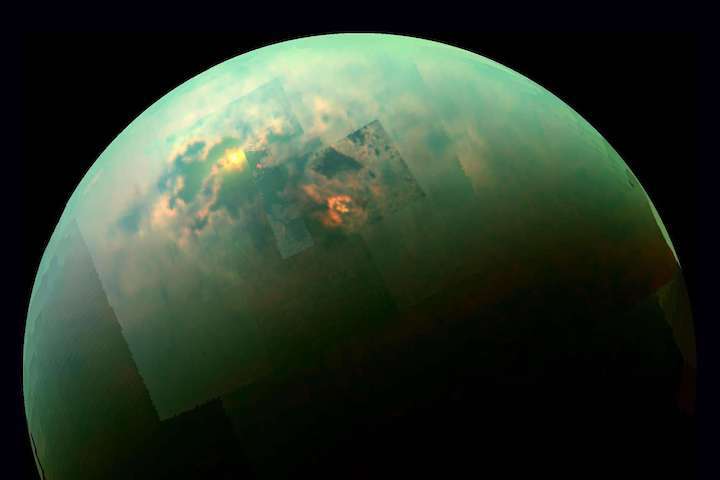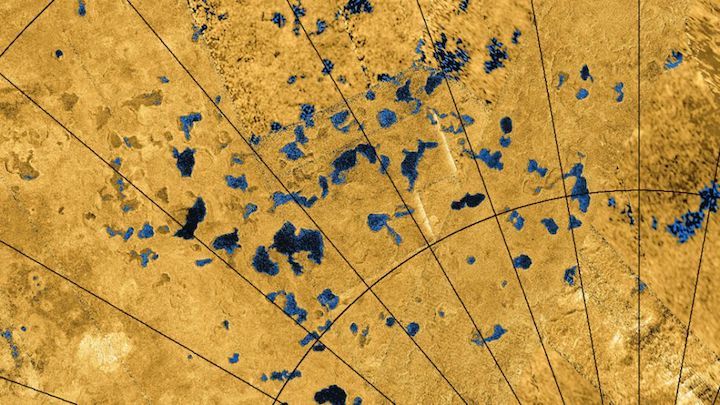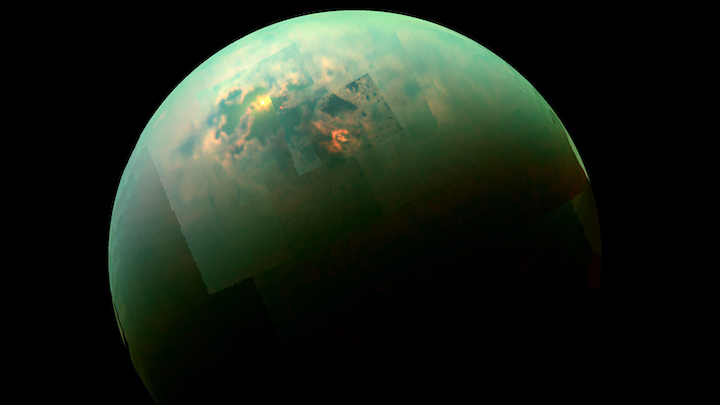16.04.2019

Titan is the only other place in the solar system with liquid on its surface

Picture a world where rain falls, gathers in lakes and ponds, seeps into the surrounding rock, and evaporates away, only to fall again. There's just one catch: The world is Saturn's moon, Titan, where the rain isn't water; it's liquid methane.
Two new papers explore how this eerily familiar, waterless "water cycle" manifests on Titan's surface. To do so, two separate research teams turned to data from the Cassini mission, which ended its stay at the Saturn system in September 2017. The spacecraft flew past the massive moon more than 100 times, gathering crucial observations of this strange world as it did so.
Some of those observations showed scientists something truly extraordinary: their first glimpse of liquid currently on the landscape, rather than mere ghosts of such liquid features. "Titan is the only world outside the Earth where we see bodies of liquid on the surface," Rosaly Lopes, a planetary scientist at NASA's Jet Propulsion Laboratory who worked on the Cassini mission but wasn't involved in either of the new papers. "Some of us like to call Titan the Earth of the outer solar system."
"Titan is the most interesting moon in the solar system. I think that gets me some enemies, but I think it's actually true," Shannon MacKenzie, lead author on one of the new studies and a planetary scientist at Johns Hopkins University's Applied Physics Laboratory, told Space.com. But that doesn't mean the moon is straightforward. "Titan throws us a lot of curveballs," she said.
MacKenzie's study analyzes one potential curveball: three small features that appeared to be liquid-filled lakes when Cassini first spotted them, but seem to have dried up by the time the spacecraft returned to the area. The observations suggest that the liquid either evaporated or seeped into the surrounding planetary surface.
These "phantom lakes" may be evidence of seasonal changes on the moon, MacKenzie and her coauthors believe. (Seven Earth years passed between the spacecraft's two observations of the area, during which the northern hemisphere of the moon transitioned from winter to spring.)
But the situation may not be quite that simple, since the two sets of observations were taken by different instruments. Cassini was built to gather data with either its radar instrument or its visual and infrared light cameras, but not both simultaneously. And during the spacecraft's first pass, the region was too dark to use the cameras.
So MacKenzie and her colleagues had to factor in the change in instruments as a potential variable. But she's still confident that something is different in the two passes, and that it's pretty plausible that liquid was there, then disappeared. Even if the different signals over the two flybys were caused by some other phenomenon, MacKenzie said she's still intrigued by what that could tell us about the strange moon, which is among scientists' plausible candidates for where life may be lurking beyond Earth.
"If we're instead looking at some newly identified materials on the surface, then that's interesting, too, because the sediments on Titan are really important for prebiotic chemistry," MacKenzie said.
But although MacKenzie focused on just three small lakes that seem to have disappeared, plenty of lakes remained visible throughout Cassini's observations of the region. In the second paper published today, scientists used radar data to study a handful of much larger lakes.
During Cassini's very last pass over Titan in April 2017, the spacecraft was programmed to gather a very specific type of data, called altimetry, over the lake region to measure the height of different substances. Marco Mastrogiuseppe, a planetary scientist at Caltech, had already used similar data to measure the depths of some of Titan's seas, much larger bodies of liquids, and the Cassini team hoped he would be able to do the same with lakes.
Mastrogiuseppe and his colleagues did so in their new paper, identifying the bottoms of lakes more than 328 feet (100 meters) deep and establishing that their contents were dominated by liquid methane. "We realized that essentially the composition of the lakes is very, very similar to the one of the mare, of the sea," he said. "We believe that these bodies are fed by local rains and then these basins, they drain liquid."
That suggests that below Titan's surface, the moon may host yet another feature reminiscent of Earth: caves. On Earth, many caves are formed by water dissolving away surrounding rock types like limestone, leaving behind a type of landscape called karst, characterized by springs, aquifers, caves and sinkholes.
Researchers studying Titan's lake region think that they see similar karst-type characteristics. They also haven't spotted channels connecting all these different liquid features, which is why Mastrogiuseppe and others suspect that some of the liquid may be seeping into the surrounding terrain, much like karst systems here on Earth.
"Titan is really this world that geologically is similar to the Earth, and studying the interactions between the liquid bodies and the geology is something that we haven't really been able to do before," Lopes said. The new studies begin to make that happen by seeing those interactions playing out live on another planetary body.
Of course, it's much more difficult to study these interactions so far away, on a world that has never been the primary focus of a mission. "We've been talking about possible missions with robotic explorers that might crawl down into lava tubes and caves on the moon and Mars," Lopes said. "Could we in the future send one of these to sort of crawl down into this terrain and into caves and find out what's underneath there?"
Such a mission likely won't happen any time soon, but NASA is seriously considering a project called Dragonfly that would land a drone on the strange moon. If selected, the mission would launch in 2025 and reach Titan nine years later. And if NASA doesn't choose Dragonfly, chances are good that another mission concept will come along. "Titan's just too cool to not go back to," MacKenzie said.
Quelle: SC
----
Update: 17.04.2019
.
NASA's Cassini Reveals Surprises with Titan's Lakes

On its final flyby of Saturn's largest moon in 2017, NASA's Cassini spacecraft gathered radar data revealing that the small liquid lakes in Titan's northern hemisphere are surprisingly deep, perched atop hills and filled with methane.
The new findings, published April 15 in Nature Astronomy, are the first confirmation of just how deep some of Titan's lakes are (more than 300 feet, or 100 meters) and of their composition. They provide new information about the way liquid methane rains on, evaporates from and seeps into Titan - the only planetary body in our solar system other than Earth known to have stable liquid on its surface.
Scientists have known that Titan's hydrologic cycle works similarly to Earth's - with one major difference. Instead of water evaporating from seas, forming clouds and rain, Titan does it all with methane and ethane. We tend to think of these hydrocarbons as a gas on Earth, unless they're pressurized in a tank. But Titan is so cold that they behave as liquids, like gasoline at room temperature on our planet.
Scientists have known that the much larger northern seas are filled with methane, but finding the smaller northern lakes filled mostly with methane was a surprise. Previously, Cassini data measured Ontario Lacus, the only major lake in Titan's southern hemisphere. There they found a roughly equal mix of methane and ethane. Ethane is slightly heavier than methane, with more carbon and hydrogen atoms in its makeup.
"Every time we make discoveries on Titan, Titan becomes more and more mysterious," said lead author Marco Mastrogiuseppe, Cassini radar scientist at Caltech in Pasadena, California. "But these new measurements help give an answer to a few key questions. We can actually now better understand the hydrology of Titan."
Adding to the oddities of Titan, with its Earth-like features carved by exotic materials, is the fact that the hydrology on one side of the northern hemisphere is completely different than the that of other side, said Cassini scientist and co-author Jonathan Lunine of Cornell University in Ithaca, New York.
"It is as if you looked down on the Earth's North Pole and could see that North America had completely different geologic setting for bodies of liquid than Asia does," Lunine said.
On the eastern side of Titan, there are big seas with low elevation, canyons and islands. On the western side: small lakes. And the new measurements show the lakes perched atop big hills and plateaus. The new radar measurements confirm earlier findings that the lakes are far above sea level, but they conjure a new image of landforms - like mesas or buttes - sticking hundreds of feet above the surrounding landscape, with deep liquid lakes on top.
The fact that these western lakes are small - just tens of miles across - but very deep also tells scientists something new about their geology: It's the best evidence yet that they likely formed when the surrounding bedrock of ice and solid organics chemically dissolved and collapsed. On Earth, similar water lakes are known as karstic lakes. Occurring in in areas like Germany, Croatia and the United States, they form when water dissolves limestone bedrock.
Alongside the investigation of deep lakes, a second paper in Nature Astronomy helps unravel more of the mystery of Titan's hydrologic cycle. Researchers used Cassini data to reveal what they call transient lakes. Different sets of observations - from radar and infrared data - seem to show liquid levels significantly changed.
The best explanation is that there was some seasonally driven change in the surface liquids, said lead author Shannon MacKenzie, planetary scientist at the Johns Hopkins Applied Physics Laboratory in Laurel, Maryland. "One possibility is that these transient features could have been shallower bodies of liquid that over the course of the season evaporated and infiltrated into the subsurface," she said.
These results and the findings from the Nature Astronomy paper on Titan's deep lakes support the idea that hydrocarbon rain feeds the lakes, which then can evaporate back into the atmosphere or drain into the subsurface, leaving reservoirs of liquid stored below.
Cassini, which arrived in the Saturn system in 2004 and ended its mission in 2017 by deliberately plunging into Saturn's atmosphere, mapped more than 620,000 square miles (1.6 million square kilometers) of liquid lakes and seas on Titan's surface. It did the work with the radar instrument, which sent out radio waves and collected a return signal (or echo) that provided information about the terrain and the liquid bodies' depth and composition, along with two imaging systems that could penetrate the moon's thick atmospheric haze.
The crucial data for the new research were gathered on Cassini's final close flyby of Titan, on April 22, 2017. It was the mission's last look at the moon's smaller lakes, and the team made the most of it. Collecting echoes from the surfaces of small lakes while Cassini zipped by Titan was a unique challenge.
"This was Cassini's last hurrah at Titan, and it really was a feat," Lunine said
The Cassini-Huygens mission is a cooperative project of NASA, ESA (European Space Agency) and the Italian Space Agency. NASA's Jet Propulsion Laboratory, a division of Caltech in Pasadena, California, manages the mission for NASA's Science Mission Directorate, Washington. JPL designed, developed and assembled the Cassini orbiter. The radar instrument was built by JPL and the Italian Space Agency, working with team members from the U.S. and several European countries.
Quelle: NASA

